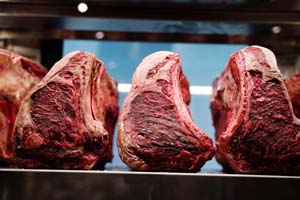
Nothing beats the taste of an especially good steak. It can be a great dinner option to celebrate a business deal or a special event like an anniversary or party. However, you may have noticed that some terms include dry-aged and wet-aged steak, and that may be a bit confusing. If you are unsure of the difference between dry-aged and wet-aged steak, we are happy to go into more detail so you can be a steak connoisseur in no time.
Depending on who you are, you may already have a preference for dry-aged or wet-aged steaks, even if you aren't necessarily sure of the differences between the two. Wet-aging is a bit of a newer process, while dry-aging has been around for years. Both are perfectly good ways to prepare steak, it just depends on personal preference which is preferred.
All meat needs time to age before being sold and eaten so that enzymes can break down the muscle tissue and make it more tender. Beef can be aged quite a bit longer than other meats, and it really is just a matter of the cut of steak and how tender it needs to be.
Dry-Aged Beef
The trusty process that has been around for hundreds of years is a wonderful option to get a delicious steak. To dry-age, whole cuts of beef or certain cuts are hung in open air at a temperature just above freezing. They can be hung there for several weeks to age. This process allows the enzymes time to work on the muscle tissue, as well as dehydrate the meat. Both of these processes affect the texture and flavor of the beef.
The main benefit of this process is that you get very tender meat with an intense flavor. On the other hand, there is a downside to this process, and that is that the meat loses quite a bit of the volume during the dehydration process, and you also need to trim away the surface of the meat before portioning and selling it, which further decreases the amount of useable meat.
Wet-Aged Beef
This is a fairly newer process that was developed along with advances in food storage, and especially refrigeration. In this process, the beef is vacuum-sealed in plastic and shipped to the store right after slaughter. The aging process is much less time, as they only age 4-10 days, depending on how long the trip takes and the type of beef. This gives the enzymes time to make the meat more tender, while not losing any of the meat due to dehydration. This also is cheaper for manufacturers, as the meat does not need a separate facility to be stored and monitored while it is aging.
Difference Between Dry Aged and Wet Aged Steak
As far as the differences, the main notable difference between the two when they are ready for consumption is going to be the flavor. Dry-aged beef tends to have more of a roasted, nutty flavor, while wet-aged beef is slightly less flavorful and may have more of a metallic taste to it.
How to Tell the Difference at a Store
In a fine restaurant, the steak will be labeled as either dry-aged or wet-aged, whereas in a grocery store you may be wondering what kind of aging your steak or beef went through. In general, unless it is labeled otherwise, most of the meat available at stores and markets is wet-aged beef, and it is aged on the way to the market for sale. Because of this, you may be more inclined to enjoy the taste of wet-aged beef over dry-aged as it is quite a different flavor and potentially one that you do not normally associate with beef.

